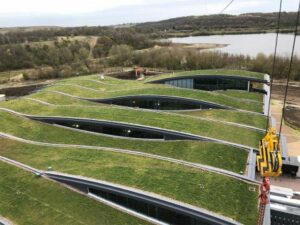Under mandatory BNG legislation, all developments in England must replace any biodiversity lost and add a minimum of 10% biodiversity to provide a net gain. The resulting habitat will be secured for at least 30 years via planning obligations or conservation covenants. The scheme applies to new housing, infrastructure and commercial developments of all sizes with large developments subject to the rules from November 2023, whilst smaller developments will be included from April 2024.
Best practice guidance dictates net gains should be delivered locally to the development site. In addition, a ‘spatial risk multiplier’ will incentivise developers to undertake biodiversity improvements within the boundary of a development (on-site), by reducing the biodiversity value of habitats delivered further away from the development.
Green and brown roofs, for example are especially useful on urban sites where there is limited space for landscaping at ground level due to other development constraints. A green roof is a flat or pitched roof covered with plants which can be as simple as sedum mats to wildflowers and a range of grasses. It creates habitat for flora and fauna and can therefore play an important part in conservation or enhancing biodiversity, particularly in urban locations.


A biodiverse brown roof is a space which can include a mix of substrate with log piles, dew ponds and mini bee hives to maximise botanical and invertebrate species. Biodiverse roofs provide opportunities for different species to green roofs, and therefore a combination of both can increase the habitat diversity of a site.

What are the BNG benefits of green and brown roofs?
- They help deliver BNG in urban environments where space is limited
- Combined with ABG blueroof stormwater attenuation they can help to control surface water and slow down run-off which helps to reduce the risk of flooding
- They can be a striking design statement and help blend a building into its surroundings
- They improve air quality, trapping pollution and absorbing gases
- Reduce the urban heat island effect through absorption of heat and the natural cooling effects of water evaporation from plants and soil
- They can improve the thermal efficiency of a building, reducing its carbon footprint
- Developers can enjoy cost savings by delivering their BNG requirements onsite
- Their sustainability credentials help deliver BREEAM and make them popular with planning departments in local authorities
- ABG’s green & blue roofing specialist installation company ABG Installs offers an ongoing maintenance service to comply with conservation covenants.